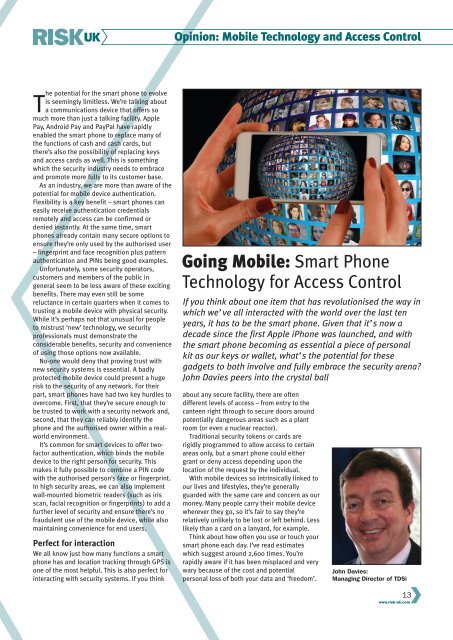RiskUKDecember2017
Create successful ePaper yourself
Turn your PDF publications into a flip-book with our unique Google optimized e-Paper software.
Opinion: Mobile Technology and Access Control<br />
The potential for the smart phone to evolve<br />
is seemingly limitless. We’re talking about<br />
a communications device that offers so<br />
much more than just a talking facility. Apple<br />
Pay, Android Pay and PayPal have rapidly<br />
enabled the smart phone to replace many of<br />
the functions of cash and cash cards, but<br />
there’s also the possibility of replacing keys<br />
and access cards as well. This is something<br />
which the security industry needs to embrace<br />
and promote more fully to its customer base.<br />
As an industry, we are more than aware of the<br />
potential for mobile device authentication.<br />
Flexibility is a key benefit – smart phones can<br />
easily receive authentication credentials<br />
remotely and access can be confirmed or<br />
denied instantly. At the same time, smart<br />
phones already contain many secure options to<br />
ensure they’re only used by the authorised user<br />
– fingerprint and face recognition plus pattern<br />
authentication and PINs being good examples.<br />
Unfortunately, some security operators,<br />
customers and members of the public in<br />
general seem to be less aware of these exciting<br />
benefits. There may even still be some<br />
reluctance in certain quarters when it comes to<br />
trusting a mobile device with physical security.<br />
While it’s perhaps not that unusual for people<br />
to mistrust ‘new’ technology, we security<br />
professionals must demonstrate the<br />
considerable benefits, security and convenience<br />
of using those options now available.<br />
No-one would deny that proving trust with<br />
new security systems is essential. A badly<br />
protected mobile device could present a huge<br />
risk to the security of any network. For their<br />
part, smart phones have had two key hurdles to<br />
overcome. First, that they’re secure enough to<br />
be trusted to work with a security network and,<br />
second, that they can reliably identify the<br />
phone and the authorised owner within a realworld<br />
environment.<br />
It’s common for smart devices to offer twofactor<br />
authentication, which binds the mobile<br />
device to the right person for security. This<br />
makes it fully possible to combine a PIN code<br />
with the authorised person’s face or fingerprint.<br />
In high security areas, we can also implement<br />
wall-mounted biometric readers (such as iris<br />
scan, facial recognition or fingerprints) to add a<br />
further level of security and ensure there’s no<br />
fraudulent use of the mobile device, while also<br />
maintaining convenience for end users.<br />
Perfect for interaction<br />
We all know just how many functions a smart<br />
phone has and location tracking through GPS is<br />
one of the most helpful. This is also perfect for<br />
interacting with security systems. If you think<br />
Going Mobile: Smart Phone<br />
Technology for Access Control<br />
If you think about one item that has revolutionised the way in<br />
which we’ve all interacted with the world over the last ten<br />
years, it has to be the smart phone. Given that it’s now a<br />
decade since the first Apple iPhone was launched, and with<br />
the smart phone becoming as essential a piece of personal<br />
kit as our keys or wallet, what’s the potential for these<br />
gadgets to both involve and fully embrace the security arena?<br />
John Davies peers into the crystal ball<br />
about any secure facility, there are often<br />
different levels of access – from entry to the<br />
canteen right through to secure doors around<br />
potentially dangerous areas such as a plant<br />
room (or even a nuclear reactor).<br />
Traditional security tokens or cards are<br />
rigidly programmed to allow access to certain<br />
areas only, but a smart phone could either<br />
grant or deny access depending upon the<br />
location of the request by the individual.<br />
With mobile devices so intrinsically linked to<br />
our lives and lifestyles, they’re generally<br />
guarded with the same care and concern as our<br />
money. Many people carry their mobile device<br />
wherever they go, so it’s fair to say they’re<br />
relatively unlikely to be lost or left behind. Less<br />
likely than a card on a lanyard, for example.<br />
Think about how often you use or touch your<br />
smart phone each day. I’ve read estimates<br />
which suggest around 2,600 times. You’re<br />
rapidly aware if it has been misplaced and very<br />
wary because of the cost and potential<br />
personal loss of both your data and ‘freedom’.<br />
John Davies:<br />
Managing Director of TDSi<br />
13<br />
www.risk-uk.com

















